Elina Virtanen
About the Author
Born in Turku in 1995, Elina Virtanen’s fascination with coins began early, sparked by her grandfather’s collection. This childhood curiosity blossomed into a passion, leading her to specialize in Numismatics. After a Master’s in Archaeology from the University of Helsinki, her groundbreaking thesis on Viking Age coin hoards propelled her into the field.
By 26, Elina became the youngest numismatic specialist at the National Museum of Finland. Her days involve the meticulous study and preservation of Finland’s coin heritage.
At 30, Elina is a rising figure, passionately sharing her expertise through public outreach and inspiring a new appreciation for the history held within each coin. Her dedication ensures these silent stories continue to resonate.

Connect with Elina:



Unlocking the Value 1776-1976 Bicentennial Coins: A Collector’s Guide
1776-1976 Philadelphia Bicentennial Quarter
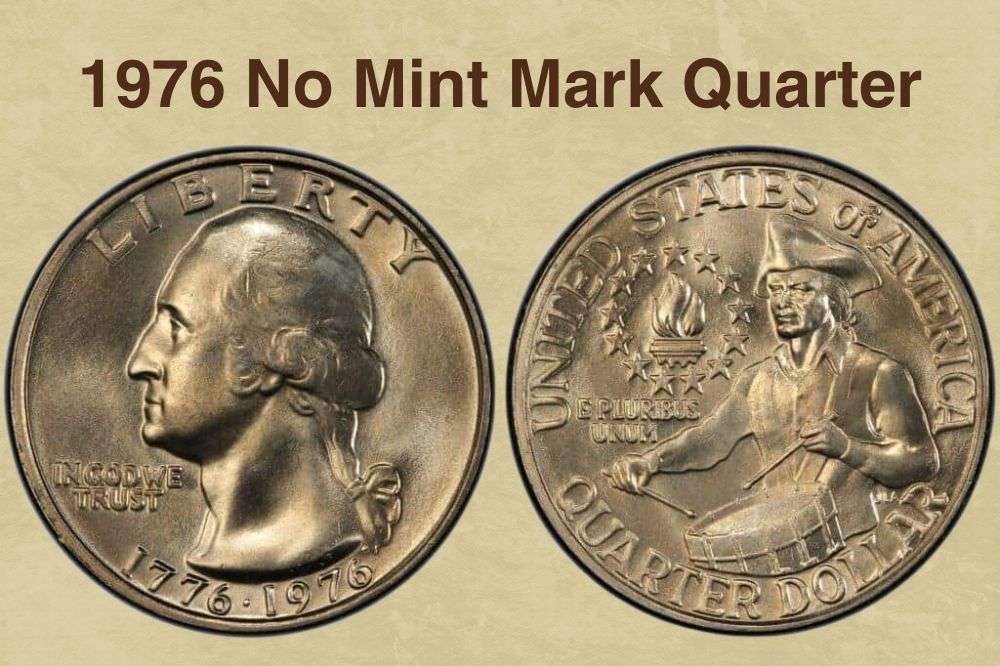
| Name | 1776-1976 Philadelphia Bicentennial Quarter Dollar |
| Mint | Philadelphia |
| Composition | outer layers of 75% copper, 25% nickel bonded to a core of pure copper |
| Mintage | 809,784,016 |
| Price (USD) | $150~ |
Listed prices are approximate and may vary depending on the coin’s condition, market demand, and other factors
Historical Context
The winning designs were selected to grace the reverse of these commemorative coins, all of which bore the dual date 1776-1976, a unique feature intended to link the coins directly to the bicentennial year, irrespective of whether they were minted in 1975 or 1976. This deliberate approach aimed to maximize public engagement with the bicentennial celebration by ensuring these commemorative coins were widely circulated and readily accessible, prompting many to later wonder about the 1776 quarter 1976 value and the general quarter dollar value 1776 to 1976.
Production and Specifications
These coins were composed of a copper core with an outer layer, or clad, made of a copper-nickel alloy (91.67% copper and 8.33% nickel in total, or a 75% copper and 25% nickel coating over a pure copper center).
The sheer number of Bicentennial Quarters produced in Philadelphia contributed to their widespread presence in circulation for many years, leading to questions like how much is a 1776 to 1976 quarter worth with no mint mark and considerations of the 1776 to 1976 d quarter value. While some hope to find error quarters worth money 1776 1976, and specifically a 1776 to 1976 quarter dollar drummer boy error, the standard circulated coins, much like the 1975 quarter value coins of that era, typically hold face value unless in exceptional condition.
The reverse of these features a 1776 to 1976 drummer boy. The absence of a mint mark indicates a Philadelphia origin, crucial for understanding a 1776 to 1976 quarter no mint mark.
Market Value
| Condition | Estimated Value |
| Circulated | $0.25 – $0.85 |
| Uncirculated (MS63) | $4 |
| Uncirculated (MS65) | $15 – $26 |
| Uncirculated (MS66) | $30 – $45 |
| Uncirculated (MS67) | $75 – $100 |
| Uncirculated (MS67+) | $43 – $2350 |
| Uncirculated (MS68) | $990 – $3750 |
| Double Die Obverse | $200 – $1000+ |
| Struck on Dime Planchet | $9200 |
Identifying a Philadelphia Bicentennial Quarter
Dual Date & Design:
- Look for the 1776-1976 date on the obverse (front).
- The reverse (back) features a drummer boy design.
Mint Mark Identification:
- Philadelphia-minted quarters do not have a mint mark.
- Denver (“D”) and San Francisco (“S”) mint marks are found near Washington’s neck on the obverse.
Error Detection:
- Use a magnifying glass or jeweler’s loupe for close inspection.
- Check for doubled lettering or imagery, especially around:
- The word “LIBERTY”
- The drummer boy design
Edge Examination:
- Philadelphia Bicentennial Quarters are clad coins (copper-nickel over copper).
- The edge should show a copper stripe.
Silver Composition Check (Rare):
If the coin appears silver (unusual for circulation strikes), weigh it:
- Clad coins weigh ~5.67 grams.
- Silver versions (proof/mint sets) weigh the same but have a different composition.
1776-1976 D Denver Bicentennial Quarter
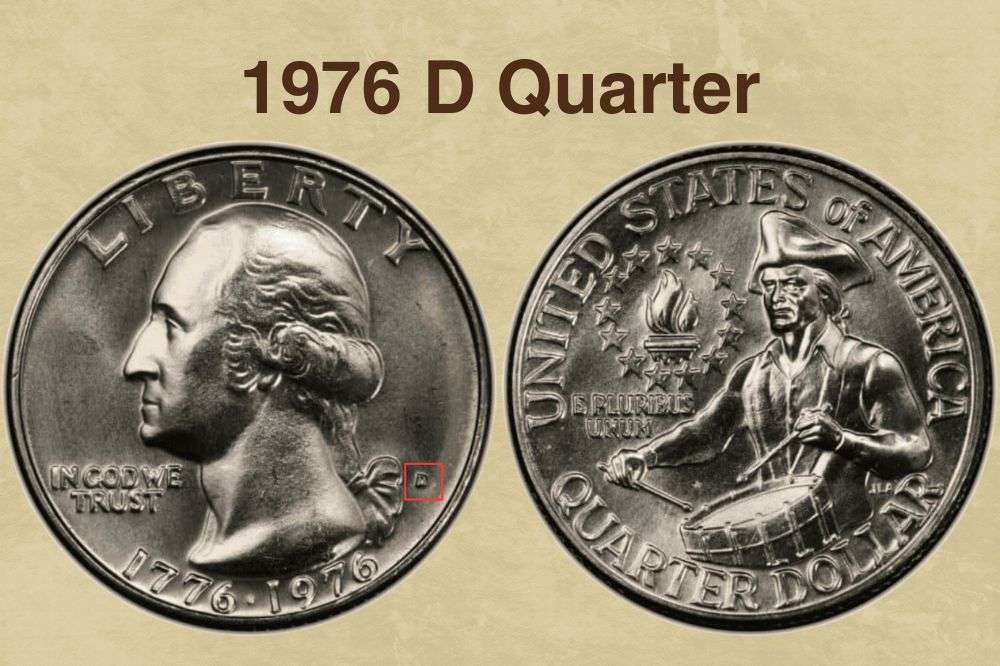
| Name | 1776-1976 D Denver Bicentennial Quarter Dollar |
| Mint | Denver |
| Composition | outer layers of 75% copper, 25% nickel bonded to a core of pure copper |
| Mintage | 860,118,839 |
| Price (USD) | $150~ |
Listed prices are approximate and may vary depending on the coin’s condition, market demand, and other factors
Historical Context
The 1976 Bicentennial Quarter was released during a period of significant national pride as the United States celebrated its 200th anniversary. To commemorate this milestone, the U.S. Mint decided to issue special versions of the quarter, half dollar, and dollar coins. A public competition was held to select new reverse designs for these coins, all of which would bear the dual date “1776-1976”.
Production and Specifications
The Denver Mint played a crucial role in producing the Bicentennial Quarter for general circulation. A total of 860,118,839 clad Bicentennial Quarters were struck at the Denver facility. These coins have a copper core with a copper-nickel alloy outer layer, consisting of 91.67% copper and 8.33% nickel in total.
For those interested in the 1776 quarter value, the Denver-minted (“D”) examples, impacting the 1776 quarter 1976 d value, are a specific area of inquiry. Errors, such as a 1776 to 1976 quarter error or a misprint 1976 quarter error, are sought after by some collectors. The reverse design, featuring a drummer, leads to searches for “drummer boy quarter errors” and “drummer value quarters worth money 1776 1976,” although the text here focuses on Denver production.
Market Value
| Condition | Estimated Value |
| Circulated | $0.25 – $1 |
| Uncirculated (MS66) | $10 – $40 |
| Uncirculated (MS67) | $30 – $100 |
| Uncirculated (MS68) | $990 – $6463 |
| Filled D Error | $5 – $50+ |
| Double Die Obverse | $200 – $8400+ |
| Struck on Dime Planchet | ~$9200 |
Identifying a Denver (D) Bicentennial Quarter
Dual Date & Design:
- Look for the 1776-1976 date on the obverse (front).
- The reverse (back) features the colonial drummer design.
Mint Mark Identification:
- Denver-minted quarters have a small “D” mint mark on the obverse.
- The “D” is located to the right of George Washington’s portrait.
Error Detection:
Inspect the coin carefully for errors, such as:
- A filled or missing “D” mint mark.
- Doubling on the obverse (e.g., letters, date, or Washington’s profile).
Edge Examination:
- Denver Bicentennial Quarters are clad coins (copper-nickel over copper).
- The edge should show a copper stripe.
1776-1976 S Proof Bicentennial Quarter
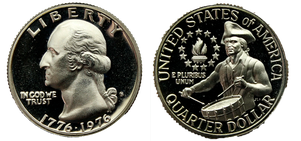
| Name | 1776-1976 S Proof Bicentennial Quarter Dollar |
| Mint | San Francisco |
| Composition | outer layers of 75% copper, 25% nickel bonded to a core of pure copper |
| Mintage | 7,059,099 |
| Price (USD) | $150~ |
Listed prices are approximate and may vary depending on the coin’s condition, market demand, and other factors
Historical Context
As the United States approached its 200th anniversary in 1976, a wave of national pride swept the country. To mark this significant milestone, the U.S. Mint decided to issue commemorative versions of the quarter, half dollar, and dollar coins for circulation. A public design competition was held to select the new reverse designs for these coins, all of which would feature the dual date “1776-1976”. Many people wonder if 1976 quarter worth anything beyond face value.
Production and Specifications
The clad proof version has a copper core with a copper-nickel alloy outer layer, weighing approximately 5.67 grams with a diameter of 24.3 millimeters. The 40% silver proof version contains 40% silver and 60% copper, weighing slightly more at 5.75 grams with the same diameter.
The mintage figures for the 1976-S Proof Bicentennial Quarter are approximately 7,059,099 for the clad version and 4,000,000 for the 40% silver version. Errors on these coins, a 1776 to 1976 quarter dollar error, can sometimes increase their value, contributing to the discussion of “quarters worth money 1776 1976”.
The value of 1976 quarter proofs, especially silver ones, is generally higher than clad circulated versions. Information regarding a 1976 quarter d or the 1776 to 1976 d quarter dollar value pertains to Denver-minted coins, not San Francisco proofs. Similarly, a 1776 to 1976 quarter dollar no mint mark would refer to Philadelphia-minted coins.
The design featuring a 1776 to 1976 drummer boy quarter is consistent across all mints for the bicentennial. Finding a quarter with 1776 and 1976 is expected for these commemoratives, and the specific value can vary, even for a 1776 to 1976 quarter d if it’s a proof struck in Denver (though the text indicates San Francisco produced proofs). The general query of “are 1976 quarters worth anything” is often answered by considering condition, mint mark, and whether it’s a proof or has an error.
Market Value
| Condition | Estimated Value |
| PR60–PR65 | $2 – $5 |
| PR66–PR69 | $5 – $15 |
| PR70 (Deep Cameo) | $10 – $30 |
| PR60–PR65 | $5 – $15 |
| PR66–PR69 | $15 – $40 |
| PR70 (Deep Cameo) | $50 – $160 |
| Double Die Obverse | $200 – $1000+ |
| No “S” Mint Mark | $1000+ |
Identifying an S Proof Bicentennial Quarter
- Dual Date: The obverse will show “1776-1976” below George Washington’s portrait.
- “S” Mint Mark: The presence of a small “S” mint mark on the obverse, typically to the right of Washington’s neck.
- Proof Finish: A brilliant, mirror-like surface on both the obverse and reverse, with sharp, well-defined details.
- Reverse Design: The colonial drummer boy with the victory torch and 13 stars.
- Weight and Composition: Silver proof versions will weigh slightly more (5.75 grams) and have a silver appearance compared to the clad version (5.67 grams) which may show a copper stripe on the edge.
1776-1976 S Silver Bicentennial Quarter
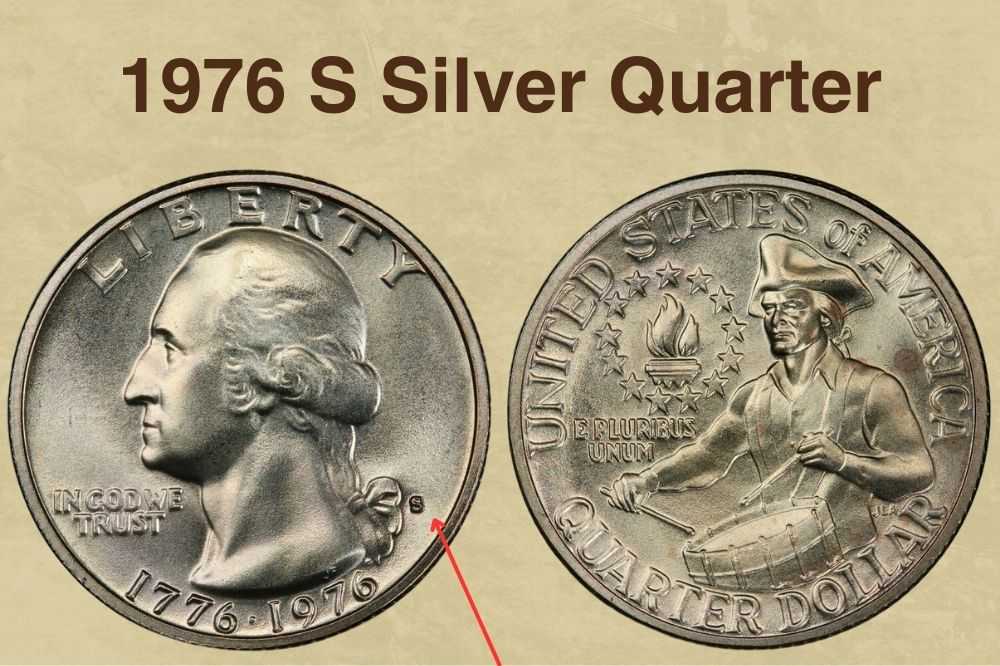
| Name | 1776-1976 S Silver Bicentennial Quarter Dollar |
| Mint | San Francisco |
| Composition | 40% silver, 60% copper |
| Mintage | 11,000,000 |
| Price (USD) | $150~ |
Listed prices are approximate and may vary depending on the coin’s condition, market demand, and other factors
Historical Context
To ensure that the new reverse designs would appropriately reflect the significance of the bicentennial, the U.S. Treasury held a nationwide design competition in 1973. This open contest invited American citizens to submit their artistic interpretations of the bicentennial theme for the reverse of the designated coin denominations. For the quarter 1776-1976, the winning design was submitted by Jack L. Ahr, featuring a striking image of a colonial drummer.
While the reverse underwent this temporary redesign, the obverse of the a quarter dollar retained the familiar portrait of George Washington, originally designed by John Flanagan. However, in a unique departure from standard practice, the obverse also featured the dual date “1776-1976,” prominently marking the bicentennial anniversary. Many people wonder how much is a 1776 to 1976 bicentennial quarter worth.
Production and Specifications
When comparing these figures to the mintage of the copper-nickel clad Bicentennial quarters, the difference in production volume becomes apparent. The Philadelphia Mint (no mint mark) produced a staggering 809,784,016 clad quarters, while the Denver Mint (D) struck 860,118,839. Additionally, the San Francisco Mint also produced 7,059,099 copper-nickel clad proof quarters. The significantly lower mintage of the 1976-S Silver Bicentennial Quarter, particularly the proof version, is a key reason for its higher collector value compared to the much more common clad versions.
The uncirculated silver quarters also have a substantially lower mintage than the circulating clad coins, contributing to their increased desirability among numismatists. For collectors seeking a 1776 to 1976 quarter d mint mark, Denver-minted examples are readily available in clad.
Errors, such as a 1776 misprint 1976 quarter error or other 1976 quarter errors, can affect their value. The specific details of a 1976 quarter error list would provide more insight into these variations. The common inquiry of “what is a 1776 to 1976 quarter worth” often depends on the mint mark, condition, and any potential errors. A 1776 to 1976 quarter value no mint mark refers to Philadelphia’s output.
The question of “are 1776 to 1976 quarters worth anything” is generally answered yes, with uncirculated and silver proofs holding more value. It’s also common to ask “how much is a 1776 quarter worth,” though in this context, it almost always refers to the bicentennial issue. It’s important to note that “1776-1976 quater” is simply a variation in spelling for the same coin. Finally, “1776 to 1996 quarter” is an incorrect date range, as the bicentennial quarters are specifically dated 1776-1976.
Market Value
| Condition | Estimated Value |
| Good (G) | $2.30 |
| Very Good (VG) | $2.40 |
| Fine (F) | $2.50 |
| Very Fine (VF) | $2.75 |
| Extremely Fine (XF) | $3.00 |
| About Unc. (AU-50) | $3.10 |
| MS-60 | $3.50 |
| MS-63 | $5.00 |
| MS-65 | $12.50 |
| MS-67 | $30.00 |
| MS-68 | $85.00 |
| MS-69 | $10,000.00 |
| PR-62 | $5 |
| PR-65 | $8 |
| PR-67 | $12 |
| PR-69 | $28 |
| PR-70 | $125 |
1776-1976 S Silver Proof Bicentennial Quarter
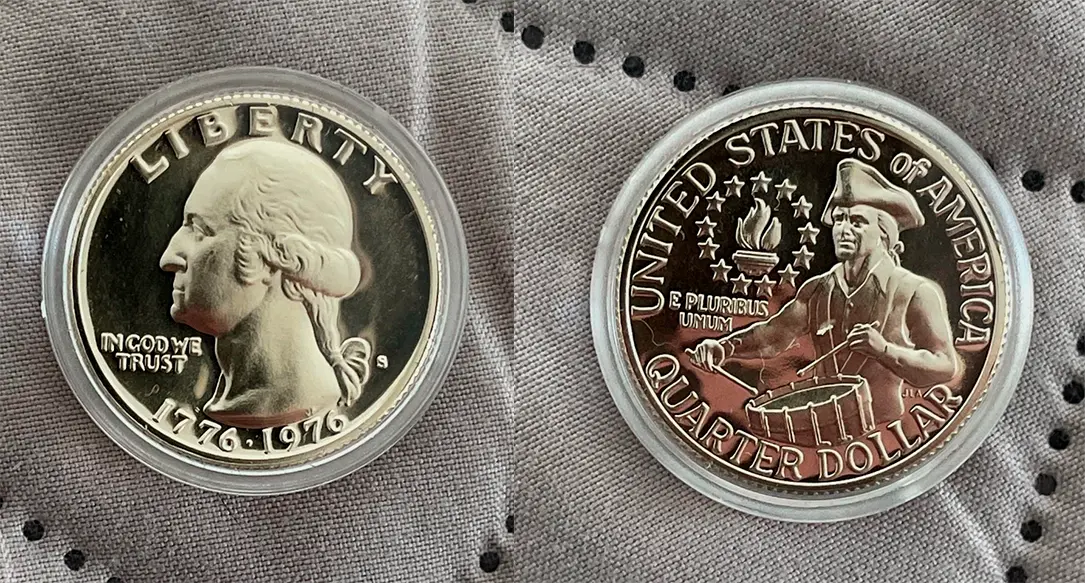
| Name | 1776-1976 S Silver Proof Bicentennial Quarter Dollar |
| Mint | San Francisco |
| Composition | 40% silver, 60% copper |
| Mintage | 4,000,000 |
| Price (USD) | $150~ |
Listed prices are approximate and may vary depending on the coin’s condition, market demand, and other factors
Historical Context
As the United States approached its 200th anniversary in 1976, a wave of national pride swept the country. To mark this significant milestone, the U.S. Mint decided to issue commemorative versions of the quarter, half dollar, and dollar coins for circulation. A public design competition was held to select the new reverse designs for these coins, all of which would feature the dual date “1776-1976”. This initiative aimed to engage the American public in the bicentennial celebration and ensure these special coins were widely recognized. Many people inquire about “centennial quarters worth” and “centennial quarters value”. Similarly, the question “is a 1776 to 1976 quarter worth anything” is frequently asked.
Production and Specifications
The San Francisco Mint played a unique role in the production of the Bicentennial Quarter by striking proof versions specifically for collectors. These proof coins were produced in both clad and 40% silver compositions. The clad proof version has a copper core with a copper-nickel alloy outer layer, weighing approximately 5.67 grams with a diameter of 24.3 millimeters. The 40% silver proof version contains 40% silver and 60% copper, weighing slightly more at 5.75 grams with the same diameter.
The mintage figures for the 1976-S Proof Bicentennial Quarter are approximately 7,059,099 for the clad version and 4,000,000 for the 40% silver version. The “1776 1976 quarter value” often depends on whether it’s a clad circulated coin, a clad proof, or a silver proof. The “1776 to 1976 quarter mint mark” is crucial for identification and value, with “S” indicating San Francisco proof production in this text. The “quarter dollar 1776 to 1976 value” is a common query, as is “what is a 1976 quarter worth”. The value of a “how much is a 1976 drummer boy quarter worth” is tied to its condition and whether it’s a proof.
The question “what makes the 1776-1976 quarter so valuable?” often points to the silver content in proofs and high uncirculated grades. While “quarter dollar 1776 to 1976 valor” and “quarter dollar 1776 to 1976 precio” are Spanish terms for value and price, they reflect the same interest in the coin’s worth. The general “1776-1976 quarter worth” is a common inquiry for collectors and the public, especially when they encounter a “quarter with two dates”.
Market Value
| Condition | Estimated Value |
| PR60–PR65 | $2 – $5 |
| PR66–PR69 | $5 – $15 |
| PR70 (Deep Cameo) | $10 – $30 |
| PR60–PR65 | $5 – $15 |
| PR66–PR69 | $15 – $40 |
| PR70 (Deep Cameo) | $50 – $160 |
| Double Die Obverse | $200 – $1000+ |
| No “S” Mint Mark | $1000+ |
Identifying an S Proof Bicentennial Quarter
- Dual Date: The obverse will show “1776-1976” below George Washington’s portrait.
- “S” Mint Mark: The presence of a small “S” mint mark on the obverse, typically to the right of Washington’s neck.
- Proof Finish: A brilliant, mirror-like surface on both the obverse and reverse, with sharp, well-defined details.
- Reverse Design: The colonial drummer boy with the victory torch and 13 stars.
- Weight and Composition: Silver proof versions will weigh slightly more (5.75 grams) and have a silver appearance compared to the clad version (5.67 grams) which may show a copper stripe on the edge.
In conclusion, the 1776-1976 Bicentennial Quarter, produced across Philadelphia, Denver, and San Francisco Mints in clad and silver compositions, holds varying values based on mint mark, condition, and errors. Proof versions and those with errors generally command higher prices than circulated clad coins.